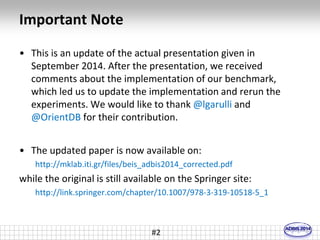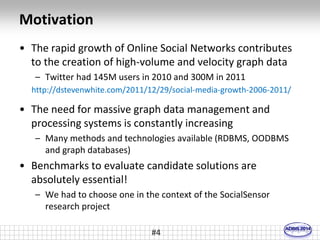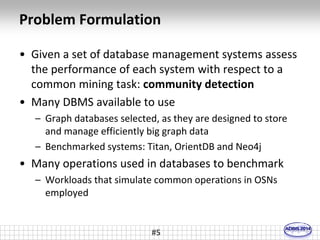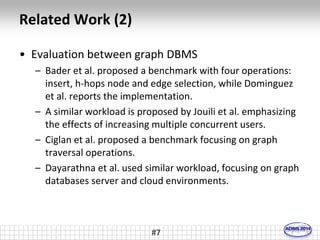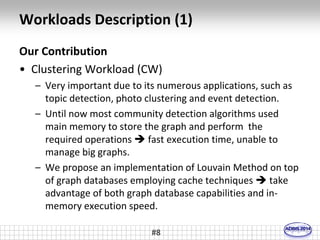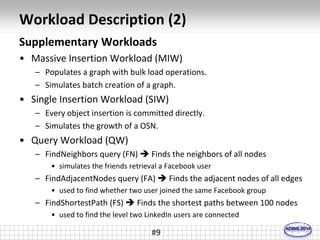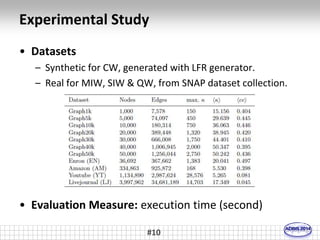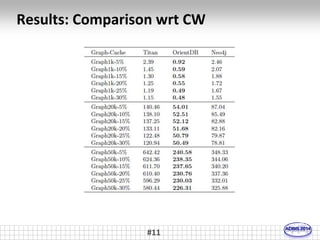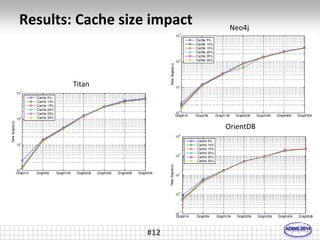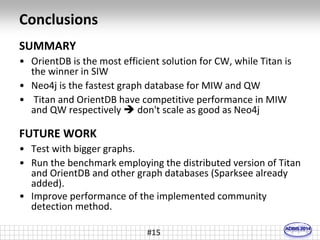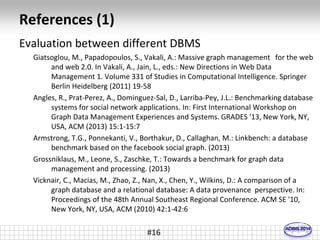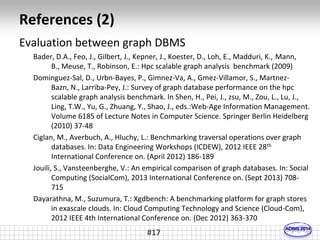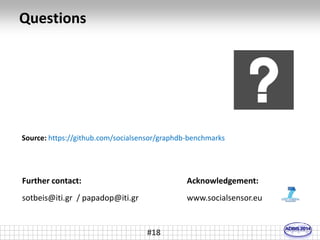Benchmarking graph databases on the problem of community detection
- 1. Benchmarking graph databases on the problem of community detection Sotirios Beis, Symeon Papadopoulos, Yiannis Kompatsiaris Centre for Research and Technology Hellas, Information Technologies Institute (CERTH-ITI) ADBIS 2014 Conference Ohrid, Republic of Macedonia, September 7-10, 2014
- 2. Important Note ÔÇó This is an update of the actual presentation given in September 2014. After the presentation, we received comments about the implementation of our benchmark, which led us to update the implementation and rerun the experiments. We would like to thank @lgarulli and @OrientDB for their contribution. ÔÇó The updated paper is now available on: http://mklab.iti.gr/files/beis_adbis2014_corrected.pdf while the original is still available on the Springer site: http://link.springer.com/chapter/10.1007/978-3-319-10518-5_1 #2
- 3. #3 Overview ÔÇó Problem formulation ÔÇó Related work ÔÇó Workload description ÔÇó Evaluation ÔÇó Conclusions
- 4. Motivation ÔÇó The rapid growth of Online Social Networks contributes to the creation of high-volume and velocity graph data ÔÇô Twitter had 145M users in 2010 and 300M in 2011 http://dstevenwhite.com/2011/12/29/social-media-growth-2006-2011/ ÔÇó The need for massive graph data management and processing systems is constantly increasing ÔÇô Many methods and technologies available (RDBMS, OODBMS and graph databases) ÔÇó Benchmarks to evaluate candidate solutions are absolutely essential! ÔÇô We had to choose one in the context of the SocialSensor research project #4
- 5. Problem Formulation ÔÇó Given a set of database management systems assess the performance of each system with respect to a common mining task: community detection ÔÇó Many DBMS available to use ÔÇô Graph databases selected, as they are designed to store and manage efficiently big graph data ÔÇô Benchmarked systems: Titan, OrientDB and Neo4j ÔÇó Many operations used in databases to benchmark ÔÇô Workloads that simulate common operations in OSNs employed #5
- 6. Related Work (1) ÔÇó Evaluation between different DBMS ÔÇô Giatsoglou et al. focused on the Social Tagging System use case scenario ÔÇô Angles et al. and Armstrong et al. proposed a synthetic graph generator with OSN characteristics and use this data for evaluation ÔÇô Grossniklaus et al. used a workloads that cover a wide variety of graph data use case ÔÇô Vicknair et al. utilized query workload that simulates typical operations performed in provenance system #6
- 7. Related Work (2) ÔÇó Evaluation between graph DBMS ÔÇô Bader et al. proposed a benchmark with four operations: insert, h-hops node and edge selection, while Dominguez et al. reports the implementation. ÔÇô A similar workload is proposed by Jouili et al. emphasizing the effects of increasing multiple concurrent users. ÔÇô Ciglan et al. proposed a benchmark focusing on graph traversal operations. ÔÇô Dayarathna et al. used similar workload, focusing on graph databases server and cloud environments. #7
- 8. Workloads Description (1) Our Contribution ÔÇó Clustering Workload (CW) ÔÇô Very important due to its numerous applications, such as topic detection, photo clustering and event detection. ÔÇô Until now most community detection algorithms used main memory to store the graph and perform the required operations ´â¿ fast execution time, unable to manage big graphs. ÔÇô We propose an implementation of Louvain Method on top of graph databases employing cache techniques ´â¿ take advantage of both graph database capabilities and in-memory execution speed. #8
- 9. Workload Description (2) Supplementary Workloads ÔÇó Massive Insertion Workload (MIW) ÔÇô Populates a graph with bulk load operations. ÔÇô Simulates batch creation of a graph. ÔÇó Single Insertion Workload (SIW) ÔÇô Every object insertion is committed directly. ÔÇô Simulates the growth of a OSN. ÔÇó Query Workload (QW) ÔÇô FindNeighbors query (FN) ´â¿ Finds the neighbors of all nodes ÔÇó simulates the friends retrieval a Facebook user ÔÇô FindAdjacentNodes query (FA) ´â¿ Finds the adjacent nodes of all edges ÔÇó used to find whether two user joined the same Facebook group ÔÇô FindShortestPath (FS) ´â¿ Finds the shortest paths between 100 nodes ÔÇó used to find the level two LinkedIn users are connected #9
- 10. Experimental Study ÔÇó Datasets ÔÇô Synthetic for CW, generated with LFR generator. ÔÇô Real for MIW, SIW & QW, from SNAP dataset collection. ÔÇó Evaluation Measure: execution time (second) #10
- 11. Results: Comparison wrt CW #11
- 12. Results: Cache size impact #12 Titan Neo4j OrientDB
- 13. Results: comparison wrt MIW and QW #13
- 14. Results: Comparison wrt SIW YouTube LiveJournal #14
- 15. Conclusions SUMMARY ÔÇó OrientDB is the most efficient solution for CW, while Titan is #15 the winner in SIW ÔÇó Neo4j is the fastest graph database for MIW and QW ÔÇó Titan and OrientDB have competitive performance in MIW and QW respectively ´â¿ don't scale as good as Neo4j FUTURE WORK ÔÇó Test with bigger graphs. ÔÇó Run the benchmark employing the distributed version of Titan and OrientDB and other graph databases (Sparksee already added). ÔÇó Improve performance of the implemented community detection method.
- 16. References (1) Evaluation between different DBMS Giatsoglou, M., Papadopoulos, S., Vakali, A.: Massive graph management for the web and web 2.0. In Vakali, A., Jain, L., eds.: New Directions in Web Data Management 1. Volume 331 of Studies in Computational Intelligence. Springer Berlin Heidelberg (2011) 19-58 Angles, R., Prat-Perez, A., Dominguez-Sal, D., Larriba-Pey, J.L.: Benchmarking database systems for social network applications. In: First International Workshop on Graph Data Management Experiences and Systems. GRADES '13, New York, NY, USA, ACM (2013) 15:1-15:7 Armstrong, T.G., Ponnekanti, V., Borthakur, D., Callaghan, M.: Linkbench: a database benchmark based on the facebook social graph. (2013) Grossniklaus, M., Leone, S., Zaschke, T.: Towards a benchmark for graph data management and processing. (2013) Vicknair, C., Macias, M., Zhao, Z., Nan, X., Chen, Y., Wilkins, D.: A comparison of a graph database and a relational database: A data provenance perspective. In: Proceedings of the 48th Annual Southeast Regional Conference. ACM SE '10, New York, NY, USA, ACM (2010) 42:1-42:6 #16
- 17. References (2) Evaluation between graph DBMS Bader, D.A., Feo, J., Gilbert, J., Kepner, J., Koester, D., Loh, E., Madduri, K., Mann, B., Meuse, T., Robinson, E.: Hpc scalable graph analysis benchmark (2009) Dominguez-Sal, D., Urbn-Bayes, P., Gimnez-Va, A., Gmez-Villamor, S., Martnez- Bazn, N., Larriba-Pey, J.: Survey of graph database performance on the hpc scalable graph analysis benchmark. In Shen, H., Pei, J., zsu, M., Zou, L., Lu, J., Ling, T.W., Yu, G., Zhuang, Y., Shao, J., eds.:Web-Age Information Management. Volume 6185 of Lecture Notes in Computer Science. Springer Berlin Heidelberg (2010) 37-48 Ciglan, M., Averbuch, A., Hluchy, L.: Benchmarking traversal operations over graph databases. In: Data Engineering Workshops (ICDEW), 2012 IEEE 28th International Conference on. (April 2012) 186-189 Jouili, S., Vansteenberghe, V.: An empirical comparison of graph databases. In: Social Computing (SocialCom), 2013 International Conference on. (Sept 2013) 708- 715 Dayarathna, M., Suzumura, T.: Xgdbench: A benchmarking platform for graph stores in exascale clouds. In: Cloud Computing Technology and Science (Cloud-Com), 2012 IEEE 4th International Conference on. (Dec 2012) 363-370 #17
- 18. Source: https://github.com/socialsensor/graphdb-benchmarks #18 Questions Further contact: sotbeis@iti.gr / papadop@iti.gr Acknowledgement: www.socialsensor.eu


